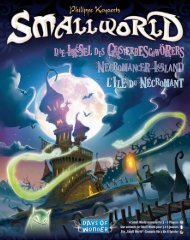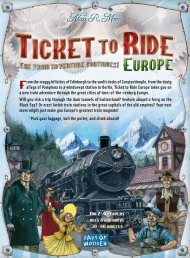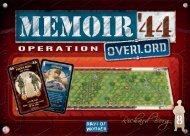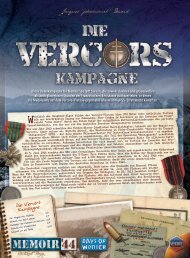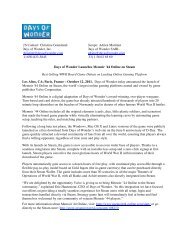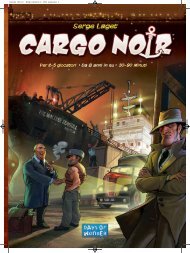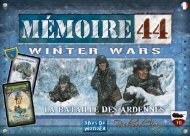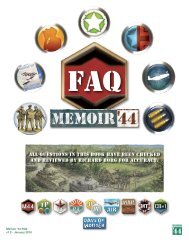You also want an ePaper? Increase the reach of your titles
YUMPU automatically turns print PDFs into web optimized ePapers that Google loves.
4Commissar Chip is the Command card he will play on his next turn. When theRussian player takes his turn, he selects one card from his hand to be placedunder the Commissar Chip and takes the card that is under the Commissar Chipand plays it as his Command card this turn. At the end <strong>of</strong> his turn, the Russianplayer draws a new Command card into his hand as normal.On the Russian player's turn, in lieu <strong>of</strong> playing the Command card alreadycommitted under the Commissar Chip, the Russian player may choose to playfrom his hand a 'Recon 1' Command card or a 'Counter-Attack' Command card.The Command card under the Commissar Chip is not used and remains under thetoken until the next turn. The Russian player may also play the Ambush card fromhis hand per the standard <strong>rules</strong>.BLITZ RULESScenarios occurring in the early years <strong>of</strong> WWII <strong>of</strong>ten use the BlitzRules .◆ The Axis player may play a 'Recon 1' card as an Air Power Tactic cardin that section (at least one target hex must be in the section): targeta group <strong>of</strong> 4 or fewer enemy units adjacent to each other. Roll 1 battledice per hex (Axis air attack).◆ Armor movement is amended as follows: An ordered Axis armorunit may move up to 3 hexes and battle while an ordered Allied armorunit may only move up to 2 hexes and battle.III. NEW MEDALSHero <strong>of</strong> the Soviet Union MedalThis medal was the highest degree <strong>of</strong> distinction in the formerUSSR. Created in 1934, it was awarded to over 12,500 people,mostly during the 1941-1945 war between Germany and theSoviet Union (called "The Great Patriotic War" by the Russians).MinefieldsThe scenario briefing notes indicate which side will layMinefields out.Minefields are set up on the board at the same time as terrain hexes. Beforeplacing any Minefield, set all Minefield pieces with their picture <strong>of</strong> the landmine face up. Mix the pieces. Now place one Minefield piece, selected at random,face up (numbered side hidden) on each Minefield hex indicated by the scenario.Return any unused Minefield pieces to the box, their numerical face still hiddenfrom the players’ view.When entering a Minefield, a unit must stop and may not move any further onthat turn.If the unit entering the Minefield is an enemy unit, turn the Minefield pieceover to reveal its strength number. If the Minefield is a decoy (“0” strength),remove it from the board. Otherwise, roll a number <strong>of</strong> Battle dice equal to theMinefield’s strength. Score 1 hit for each die matching the unit’s symbol or agrenade. Ignore all other symbols, retreat flag included. After any explosion,the Minefield remains in effect, its strength face up and visible to both players.If the unit entering the Minefield is a friendly unit (i.e. a unit that belongs tothe player who laid the Minefield down), the unit must still stop, but will ignorethe Minefield, never revealing it, if hidden, nor rolling dice.Note: In accordance with the general <strong>rules</strong> <strong>of</strong> retreat, a Minefield hasno effect on retreat moves. Therefore, a retreating unit may movethrough a Minefield without stopping. Retreating units that move ontoor through a Minefield do not roll for hits.



